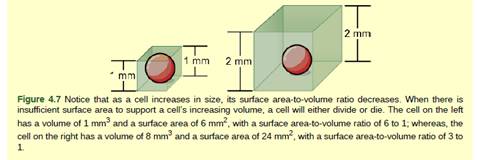
Concept explainers
Figure 4.7 Prokaryotic cells are much smaller than eukaryotic cells. What advantages might small cell size confer on a cell? What advantages might large cell size have?

To analyze:
Prokaryotic cells are much smaller than the eukaryotic cells. Discuss the advantages a small cell size and a large cell size confer on a cell.
Introduction:
A small cell size allows quick transport of molecules. A large cell size helps to separate biological process and support the synthesis of complex molecules.
Explanation of Solution
A small cell size has several advantages. It allows an easy transport of substances across the plasma membrane. Small cells have a higher surface area to volume ratio, which provide them a greater surface area for the exchange of nutrients and waste materials by spending relatively lesser energy. In a small cell, nucleus is relatively closer to the plasma membrane. This results in an efficient transport of messages.
Large cell size has its own share of advantages. It allows to be divided into compartments. Large cells have organelles. Different organelles perform different functions thus enabling the cell to build molecules that are more complex in nature.
A small cell size allows an easier transport of substance through the plasma membrane by spending a relatively lesser amount of energy. A large cell size allows to be divided into compartments. Different organelles perform different functions thereby enabling the cell to produce complex molecules.
Want to see more full solutions like this?
Chapter 4 Solutions
BIOLOGY 2E
Additional Science Textbook Solutions
College Physics
Biological Science
Campbell Essential Biology with Physiology (6th Edition)
Biology: Life on Earth (11th Edition)
Fundamentals of Anatomy & Physiology (11th Edition)
Biology: Life on Earth with Physiology (11th Edition)
- What are the main advantages of the presence of organelles in eukaryotic cells?arrow_forwardIf Prokaryotic cells do not have membrane-bound organelles, can Prokaryotic cells perform the same functions as membrane-bound organelles?arrow_forwardWhich of the following is FALSE regarding the four structures that BOTH prokaryotic and eukaryotic cells have in common and why are these essential structures for all cells?1 DNA directs protein production2 Mitochondria the power house of the cell3 Cytoplasm, aqueous interior of all cell houses organelles and other structure 4 cell membrane : regulates movement of molecules between cell and its surroundings5 ribosome build proteins according to the DNA's instructionsarrow_forward
- Contrast how prokaryotic cells and eukaryotic cells differ in terms of a) size and b) structural complexityarrow_forwardYou are given slides of two cells in lab and asked to identify which one is prokaryotic. What would you look for to determine this? a cell with transfer proteins in the membrane a cell that has ribosomes a cell that does not have any chromosomes a cell without a membrane surrounding its DNAarrow_forwardCan we think of a eukaryotic cell as being a cellular factory ?arrow_forward
- Name and describe two similarities and two differences between eukaryotic cells and prokaryotic cells. Be very specific in how they are similar or how they are different.arrow_forwardTrue or False Cell walls are present in the cells of archaea, bacteria, algae, fungi, and plants only. Photosynthetic unicellular prokaryotes such as Oscillatoria exhibit a green color when viewed under a microscope because of the presence of numerous chloroplasts. The nuclear membrane is a double-membrane structure that constitutes the outermost portion of the nucleus and is continuous with the Endoplasmic Reticulum.arrow_forwardWhat is the similarities and differences of Prokaryotic cells and Eukaryotic cells?arrow_forward
- In the micrograph below, you are seeing a collection of cells that have been stained with fluorescent dyes. One of the dyes appears green, and the other dye appears blue (when viewed with a fluorescence microscope). Based on the appearance of these stained cells, which of the following cell structures must the GREEN dye be staining? Endoplasmic reticulum Cytoskeleton Flagella Mitochondria Nucleus ..arrow_forwardDraw ONE generic eukaryotic cell that includes all of the structures and location of the processes listed below. All structures should be named. You are welcome to use the medium of your choice - draw on paper and upload a picture or use an whiteboard/doodling app and upload the picture. Cell membrane in detail Nucleus Mitochondria Rough Endoplasmic Reticulum Ribosomes Golgi apparatus Cytoplasm The location of glycolysis The location of citric acid cycle and oxidative phosphorylation The location where oxygen is needed in the cell The location of carbon dioxide production in the cell The location of DNA storage in the cell The process by which COVID-19 enters and exits a cellarrow_forwardThe endoplasmic reticulum and Golgi apparatus are both membrane-bound organelles found in eukaryotic cells. Which statement describes one way in which the endoplasmic reticulum and the Golgi apparatus work together? The Golgi apparatus assembles mRNA, and the endoplasmic reticulum translates them into proteins. The endoplasmic reticulum assembles mRNA molecules, and the Golgi apparatus translates them into proteins. The Golgi apparatus assembles proteins, and the endoplasmic reticulum modifies and packages them. The endoplasmic reticulum assembles proteins and the Golgi apparatus modifies and packages them.arrow_forward
 Biology 2eBiologyISBN:9781947172517Author:Matthew Douglas, Jung Choi, Mary Ann ClarkPublisher:OpenStax
Biology 2eBiologyISBN:9781947172517Author:Matthew Douglas, Jung Choi, Mary Ann ClarkPublisher:OpenStax
